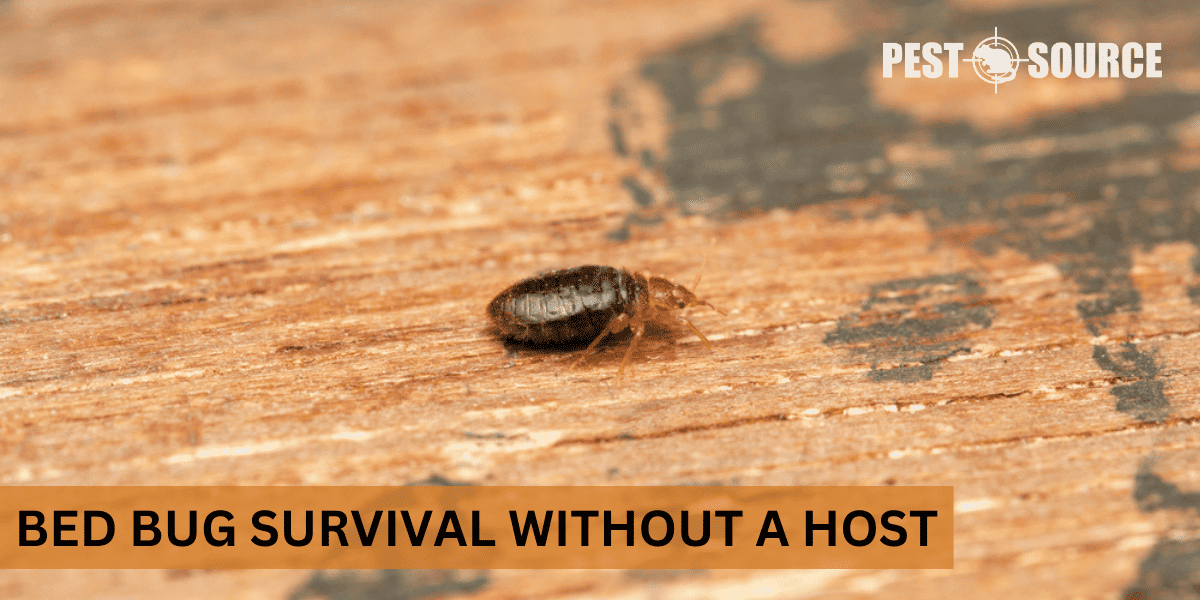Bed bugs can survive without a host for several months to a year, depending on the temperature and humidity conditions. They are resilient pests that enter a semi-dormant state when unable to feed, conserving energy until a host becomes available. The article ahead will provide a deeper insight into the survival tactics of bed bugs and factors that influence their longevity without a blood meal.
POINTS
- Bed bugs have an impressive lifespan, ranging from 10 months to 1 year in ideal conditions with a host. In the absence of a host, they can survive for up to 400 days due to their expert survival mechanisms, including reducing their metabolism during a state of dormancy.
- Bed bugs need blood to grow and reproduce, but an adult bed bug that has already fed can survive without feeding for a remarkable length of time by using its stored energy reserves.
- The survival ability of bed bugs varies in different scenarios and they can live comfortably in furniture and wood, unused mattresses, pillows, and even in an empty house, waiting patiently for their next blood meal.
- Bed bugs do not leave their chosen location voluntarily, regardless of the availability of a host. Their natural causes of death include starvation, extreme temperatures, and old age, but they may take over a year to succumb to these factors.
- Addressing a bed bug infestation requires a thorough inspection of the premises, seeking professional pest control help when necessary, and ensuring regular preventive measures, such as sealing cracks and crevices, washing fabrics, and frequent vacuuming to prevent a re-infestation.
How Do Bed Bugs Survive Without a Host?
What is the Average Lifespan of a Bed Bug?
Bed bugs are incredibly resilient pests. In ideal conditions and with access to a steady food source – usually human blood – a bed bug’s average lifespan is about 10 months to 1 year. Yes, quite surprising, isn’t it? They adapt remarkably well to their environment, making them expert survivors in the insect world.
What Factors Determine the Lifespan of Bed Bugs Without a Host?
Bed bug’s survival without a host is significantly influenced by some key factors. Predominantly, it’s the temperature and humidity of their environment. Lower temperatures and higher humidity levels can dramatically elongate the survival rate. That’s because bed bugs, being cold-blooded creatures, their metabolism drastically slows down in cooler temperatures.
The state of dormancy also plays a vital role in their survival. When food (that is, a host) is not readily available, bed bugs enter a state of dormancy known as ‘diapause’. During this time, their physical activity is reduced, enabling them to survive longer without feeding.
How Long Can Bed Bugs Live Without Human Contact?
Without having turn into a meal for a host, bed bugs can play the long waiting game. Despite their tiny size, these bugs can live up to an astonishing 400 days without feeding under room temperature conditions and with adequate humidity. This lengthy survival ability without human contact explains why an infestation can recur even after a prolonged vacancy in the property. This is a clear indication of their stubborn persistence to invade your peace.
Understanding the Survival Mechanisms of Bed Bugs
How Do Bed Bugs Survive?
Since we’ve already established that bed bugs can survive for extended periods without a host, let’s explore how they do it. The magic lies in their biological structure which allows them to enter a state of dormancy or ‘diapause’. The diapause resembles a type of hibernation where they drastically reduce their metabolic activities, thus conserving energy. During this time, they don’t feed, reproduce, or even move much. This mechanism allows them to extend their lifespan and survive without feeding.
Do Bed Bugs Need Blood to Live?
Yes, bed bugs do need blood to live, at least to reproduce and develop. However, they can still survive without it for a long time. Blood is the fuel for their growth and reproduction. Without it, they can not lay eggs or advance to their next development stage. That said, an adult bed bug that has already fed can survive without another blood meal for several months, thriving on its stored energy reserves.
How Does the Metabolism of Bed Bugs Impact Their Survival Without a Host?
The metabolism of bed bugs plays a crucial role in their survival tactics. As cold-blooded creatures, their metabolic rate is influenced by the surrounding temperature. When the temperature drops, their metabolism slows down. This reduces their need for food, allowing them to stretch their energy reserves.
Being able to control their metabolic activity level facilitates their survival when a host is not available. It lets them play the long waiting game until the next blood meal opportunity presents itself. However, bear in mind that it’s an involuntary ability, implying they can’t just switch it on or off at will.
What Happens to Bed Bugs in Different Environments?
How Long Can Bed Bugs Live on Furniture and in Wood?
Your cozy couch or antique wooden chest might just be the ideal home for a bed bug. Skilled at hiding in small crevices, these bugs can comfortably live in furniture and wood where they remain close enough to their hosts for a nighttime feast. They can survive without a host on furniture or in wood for up to 400 days given the optimal temperature and humidity conditions.
How Long Can Bed Bugs Live in an Unused Mattress?
An unused mattress is quite the haven for bed bugs. In essence, it’s their food source and nesting spot rolled into one. If the mattress was previously infested, it can harbor bed bugs for a remarkably long time. Unfed bed bugs can survive in an unused mattress for up to a year depending on the ambient temperature and humidity.
Can Bed Bugs Live in an Empty House and If So, How Long?
The cold truth is, yes, bed bugs can live in an empty house. Without a host to feed on, bed bugs could survive for several months to over a year depending on environmental conditions. Their impressive survival skills allow them to patiently wait for their next blood meal.
The bedroom may be the preferred hideout for bed bugs, but they can also endure in other parts of the house. Given different scenarios, these astounding creatures have the capability to outlast even the toughest conditions. Let’s examine the longevity of these pests in some specific circumstances.
How Long Do Bed Bugs Last in Specific Scenarios?
How Long Can Bed Bugs Live in Pillows?
Although not their favorite hiding spot, bed bugs can still comfortably reside in pillows for quite some time. In the absence of a host, they can go for several months – over a year on occasion – without a blood meal if the temperature and humidity levels are favorable.
How Long Can Bed Bugs Live in a Storage Unit?
The longevity of bed bugs in a storage unit will primarily depend on two factors: the objects placed in the unit and the ambient conditions. If furniture or clothes infested with bed bugs are stored, they could potentially survive for up to a year due to their expert dormancy mode.
How Long Can Bed Bugs Live in an Empty House?
As we’ve learned, these incredibly resilient critters can certainly survive in an empty house. In fact, they can outlive most of their counterparts by a good measure. Should they land in an empty property, they could reside there, unfed, for several months – even over a year in reality. The survival period hinges on the environmental conditions, specifically the temperature and relative humidity.
Do Bed Bugs Go Away On Their Own and How Do They Die Naturally?
Do Bed Bugs Go Away On Their Own?
First things first – No, bed bugs do not go away on their own. Despite their enormous survivability, bed bugs don’t have the capacity to pack up and leave a location independently. These critters are expert hitchhikers that linger around waiting for an opportunity to latch onto a host or to hitch a ride in your luggage. However, they never voluntarily leave their chosen area, even when there is no host available.
How Do Bed Bugs Die Naturally?
Bed bugs, like any other creature, do have a natural lifespan and will die eventually. Starvation, temperature extremes, and old age are all natural causes of death for a bed bug. However, these pests are so profoundly adaptable that their average lifespan tends to outlast most conventional pest control methods.
Will Bed Bugs Die On Their Own and If So, How Long Does It Take?
Bed bugs may eventually die off due to starvation, extreme temperatures, or simply age. However, remember that these bugs are superb survivalists, and it can take them over a year to succumb to these causes in the absence of a host. After hearing these facts, it’s clear that addressing a bed bug infestation head-on is crucial.
How to Address Bed Bug Infestations
How to Treat an Empty House for Bed Bugs?
Dealing with a bed bug infestation in an empty house shouldn’t be taken lightly. Here are a few steps to follow:
- Inspection: The first step is to thoroughly inspect the premises. Remember, bed bugs like cracks and crevices in walls, furniture, and mattresses. So, spare no corner and meticulously inspect the entire house.
- Professional Help: In extreme cases, it’s wise to call in pest control professionals. Their expertise and access to industrial-grade insecticides can assure a comprehensive clearing of the infestation.
- Preventive Measures: After warding off the bugs, take preventive steps like sealing cracks and crevices, thoroughly washing fabrics, and vacuuming regularly to prevent a re-infestation.
What Are The Key Locations Where Bed Bugs Hide in an Empty House?
In an empty house, bed bugs primarily target the following locations:
- Mattresses and bed frames: Preferred for their proximity to their human hosts.
- Furniture: Sofas, armchairs, and other furnishings may host these pests.
- Carpets and curtains: They can sneak into the fibers and hide therein.
- Cracks and crevices in the wall: They give perfect cover for their stealthy life.
Addressing the infestation involves diligent cleaning and ongoing prevention measures. However, don’t fret; despite their tenacious survivability, beating a bed bug infestation is possible with consistency and persistence.
Summarizing the Bed Bug’s Lifespan Without a Host
How Long Does a Bed Bug Live in General?
The average lifespan of a bed bug, given ideal circumstances and a regular food source, is around 10 months to 1 year. However, these resilient creatures can survive up to a staggering 400 days without feeding, thanks to their strategic survival mechanisms and cold-blooded nature.
Do Bed Bugs Eventually Go Away?
Unfortunately, no. Bed bugs do not go away on their own. While they do have natural lifespans, their impressive dormancy skills extend their survival duration to the unexpected height of over a year, surpassing most of their counterparts.
Will Bed Bugs Die Without a Host and If So, After How Long?
Bed bugs can indeed die without a host, but the timing varies. While they can’t feed, reproduce, or progress in their life cycle without a host, adult bed bugs can still survive for over a year by going into a state of dormancy where they painstakingly slow down their metabolism and conserve energy.



